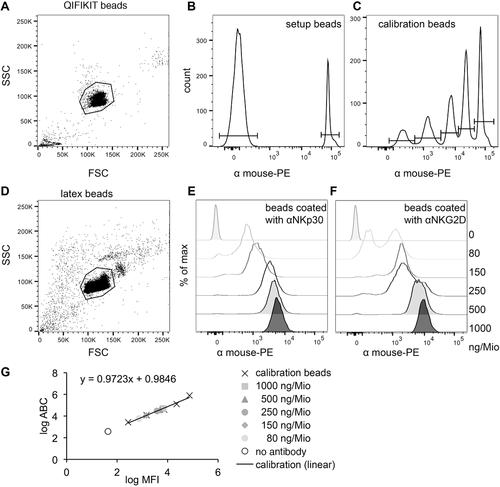{"title":"包膜乳胶珠作为人工细胞用于受体/配体相互作用的定量研究","authors":"Doris Urlaub, Carsten Watzl","doi":"10.1002/cpim.111","DOIUrl":null,"url":null,"abstract":"<p>Cellular interactions are often essential to regulate immune cell activities during an immune response. To understand the details of this process, it is necessary to study individual receptor/ligand interactions in a quantitative fashion. However, this is often very difficult or even impossible when using real cells for stimulation. Here, we present a method to use cell-sized latex beads for such studies. These beads can be coated with agonistic antibodies or specific ligands in a defined and quantifiable fashion. This creates the possibility of titrating the strength of the stimulation for a specific receptor in a three-dimensional system. Using natural killer (NK) cells as an example, we demonstrate how these beads can be used to stimulate NK cell responses. © 2020 The Authors.</p><p><b>Basic Protocol 1</b>: Covalent coating of latex beads with antibodies</p><p><b>Basic Protocol 2</b>: Quantification of the amount of antibodies on the beads with the QIFIKIT<sup>®</sup></p><p><b>Alternate Protocol 1</b>: Covalent coating of latex beads with streptavidin to bind biotinylated proteins</p><p><b>Alternate Protocol 2</b>: Quantification of the amount of protein on the beads with the QIFIKIT<sup>®</sup></p><p><b>Support Protocol</b>: Functional testing of the beads in a natural killer cell degranulation assay</p>","PeriodicalId":10733,"journal":{"name":"Current Protocols in Immunology","volume":"131 1","pages":""},"PeriodicalIF":0.0000,"publicationDate":"2020-11-04","publicationTypes":"Journal Article","fieldsOfStudy":null,"isOpenAccess":false,"openAccessPdf":"https://sci-hub-pdf.com/10.1002/cpim.111","citationCount":"2","resultStr":"{\"title\":\"Coated Latex Beads as Artificial Cells for Quantitative Investigations of Receptor/Ligand Interactions\",\"authors\":\"Doris Urlaub, Carsten Watzl\",\"doi\":\"10.1002/cpim.111\",\"DOIUrl\":null,\"url\":null,\"abstract\":\"<p>Cellular interactions are often essential to regulate immune cell activities during an immune response. To understand the details of this process, it is necessary to study individual receptor/ligand interactions in a quantitative fashion. However, this is often very difficult or even impossible when using real cells for stimulation. Here, we present a method to use cell-sized latex beads for such studies. These beads can be coated with agonistic antibodies or specific ligands in a defined and quantifiable fashion. This creates the possibility of titrating the strength of the stimulation for a specific receptor in a three-dimensional system. Using natural killer (NK) cells as an example, we demonstrate how these beads can be used to stimulate NK cell responses. © 2020 The Authors.</p><p><b>Basic Protocol 1</b>: Covalent coating of latex beads with antibodies</p><p><b>Basic Protocol 2</b>: Quantification of the amount of antibodies on the beads with the QIFIKIT<sup>®</sup></p><p><b>Alternate Protocol 1</b>: Covalent coating of latex beads with streptavidin to bind biotinylated proteins</p><p><b>Alternate Protocol 2</b>: Quantification of the amount of protein on the beads with the QIFIKIT<sup>®</sup></p><p><b>Support Protocol</b>: Functional testing of the beads in a natural killer cell degranulation assay</p>\",\"PeriodicalId\":10733,\"journal\":{\"name\":\"Current Protocols in Immunology\",\"volume\":\"131 1\",\"pages\":\"\"},\"PeriodicalIF\":0.0000,\"publicationDate\":\"2020-11-04\",\"publicationTypes\":\"Journal Article\",\"fieldsOfStudy\":null,\"isOpenAccess\":false,\"openAccessPdf\":\"https://sci-hub-pdf.com/10.1002/cpim.111\",\"citationCount\":\"2\",\"resultStr\":null,\"platform\":\"Semanticscholar\",\"paperid\":null,\"PeriodicalName\":\"Current Protocols in Immunology\",\"FirstCategoryId\":\"1085\",\"ListUrlMain\":\"https://onlinelibrary.wiley.com/doi/10.1002/cpim.111\",\"RegionNum\":0,\"RegionCategory\":null,\"ArticlePicture\":[],\"TitleCN\":null,\"AbstractTextCN\":null,\"PMCID\":null,\"EPubDate\":\"\",\"PubModel\":\"\",\"JCR\":\"Q2\",\"JCRName\":\"Immunology and Microbiology\",\"Score\":null,\"Total\":0}","platform":"Semanticscholar","paperid":null,"PeriodicalName":"Current Protocols in Immunology","FirstCategoryId":"1085","ListUrlMain":"https://onlinelibrary.wiley.com/doi/10.1002/cpim.111","RegionNum":0,"RegionCategory":null,"ArticlePicture":[],"TitleCN":null,"AbstractTextCN":null,"PMCID":null,"EPubDate":"","PubModel":"","JCR":"Q2","JCRName":"Immunology and Microbiology","Score":null,"Total":0}
引用次数: 2
Coated Latex Beads as Artificial Cells for Quantitative Investigations of Receptor/Ligand Interactions
Cellular interactions are often essential to regulate immune cell activities during an immune response. To understand the details of this process, it is necessary to study individual receptor/ligand interactions in a quantitative fashion. However, this is often very difficult or even impossible when using real cells for stimulation. Here, we present a method to use cell-sized latex beads for such studies. These beads can be coated with agonistic antibodies or specific ligands in a defined and quantifiable fashion. This creates the possibility of titrating the strength of the stimulation for a specific receptor in a three-dimensional system. Using natural killer (NK) cells as an example, we demonstrate how these beads can be used to stimulate NK cell responses. © 2020 The Authors.
Basic Protocol 1: Covalent coating of latex beads with antibodies
Basic Protocol 2: Quantification of the amount of antibodies on the beads with the QIFIKIT®
Alternate Protocol 1: Covalent coating of latex beads with streptavidin to bind biotinylated proteins
Alternate Protocol 2: Quantification of the amount of protein on the beads with the QIFIKIT®
Support Protocol: Functional testing of the beads in a natural killer cell degranulation assay


 求助内容:
求助内容: 应助结果提醒方式:
应助结果提醒方式:


